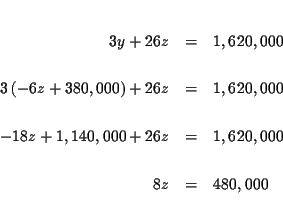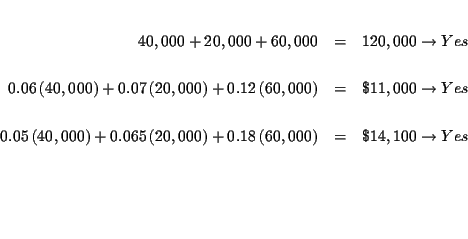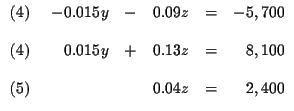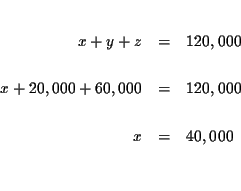 SYSTEMS OF EQUATIONS in THREE VARIABLES
SYSTEMS OF EQUATIONS in THREE VARIABLES SYSTEMS OF EQUATIONS in THREE VARIABLES
SYSTEMS OF EQUATIONS in THREE VARIABLES
It is often desirable or even necessary to use more than one variable to model a situation in a field such as business, science, psychology, engineering, education, and sociology, to name a few. When this is the case, we write and solve a system of equations in order to answer questions about the situation.
If a system of linear equations has at least one solution, it is
consistent. If the system has no solutions, it is inconsistent. If
the system has an infinity number of solutions, it is dependent.
Otherwise it is independent.
A linear equation in three variables is an equation equivalent to the
equation

Example 4:
Alicia inherited $120,000 from her uncle. She is trying to decide how to
invest it. She decides to divide the money into three parts. She will invest
one part of the money in a safe investment, one part in a relatively safe
investment, and one part in a risky investment. One option is to invest the
safe part at 6%, the relatively safe part at 7%, and the risky part at
12%. Her anticipated annual income is $11,000. The other option is to
invest the safe part at 5%, the relatively safe part at 6.5%, and the
risky part at 18%. Her anticipated income is $14,100. How much money did
she put into each part of her inhertiance.?
There are three unknowns:

The first sentence can be rewritten as [ The amount of money invested in the
safe investment ] + [ The amount of money invested in the relativey safe
investment ] + [ The amount of money in the risky investment ]
![]() The second sentence can be rewritten 0.06 times [ The amount of money
invested in the safe investment ] + 0.07 times [ The amount of money
invested in the relativey safe investment ] + 0.12 times [ The amount of
money in the risky investment ]
The second sentence can be rewritten 0.06 times [ The amount of money
invested in the safe investment ] + 0.07 times [ The amount of money
invested in the relativey safe investment ] + 0.12 times [ The amount of
money in the risky investment ]
![]() The third sentence can be rewritten 0.05 times [ The amount of money
invested in the safe investment ] + 0.065 times [ The amount of money
invested in the relativey safe investment ] + 0.18 times [ The amount of
money in the risky investment ]
The third sentence can be rewritten 0.05 times [ The amount of money
invested in the safe investment ] + 0.065 times [ The amount of money
invested in the relativey safe investment ] + 0.18 times [ The amount of
money in the risky investment ]
![]()
It is going to get boring if we keep repeating the phrases


The first sentence [ The amount of money invested in the safe investment ] + [ The amount of money invested in the relativey safe investment ] + [
The amount of money in the risky investment ]
![]() can now be
written in the algebraic form
can now be
written in the algebraic form



We have converted the problem from one described by words to one that is
described by three equations.
| x+y+z | = | 120,000 | (1) |
| 0.06x+0.07y+0.12z | = | (2) | |
| 0.05x+0.065y+0.18z | = | 14,100 | (3) |
1) Substitution,
2) Elimination
3) Matrices
SUBSTITUTION:
The process of substitution involves several steps:
Step 1: Solve for one of the variables in one of the equations. It
makes no difference which equation and which variable you choose. Let's
solve for x in equation (1).

| 0.06x+0.07y+0.12z | = | ||
| = | |||
| 7200-0.06y-0.06z+0.07y+0.12z | = | 11,000 | |
| 0.01y+0.06z | = | 3,800 | |
| y+6z | = | 380,000 | (4) |
| 0.05x+0.065y+0.18z | = | 14,100 | |
| = | 14,100 | ||
| 6,000-0.05y-0.05z+0.065y+0.18z | = | 14,100 | |
| 0.015y+0.13z | = | 8,100 | |
| 3y+26z | = | 1,620,000 | (5) |






The process of elimination involves several steps: First you reduce three
equations to two equations with two variables, and then to one equation with
one variable.
Step 1: Decide which variable you will eliminate. It makes no
difference which one you choose. Let us eliminate x first.








The process of using matrices is essentially a shortcut of the process of
elimination. Each row of the matrix represents an equation and each column
represents coefficients of one of the variables.
Step 1:
Create a three-row by four-column matrix using coefficients and the constant
of each equation.
![\begin{eqnarray*}&& \\
&&
\begin{array}{r}
(1) \\
\\
(2) \\
\\
(3)
...
...& 0.065 & & 0.18 & \vert & 14,100
\end{array}
\right] \\
&&
\end{eqnarray*}](img38.gif)
The vertical lines in the matrix stands for the equal signs between both
sides of each equation. The first column contains the coefficients of x, the
second column contains the coefficients of y, the third column contains the
coefficients of z, and the last column contains the constants.
We want to convert the original matrix
![\begin{eqnarray*}&& \\
&&
\begin{array}{r}
(1) \\
\\
(2) \\
\\
(3)
...
...& 0.065 & & 0.18 & \vert & 14,100
\end{array}
\right] \\
&&
\end{eqnarray*}](img38.gif)
![\begin{eqnarray*}&& \\
&&
\begin{array}{r}
(1) \\
\\
(2) \\
\\
(3)
...
... & \\
0 & & 0 & & 1 & \vert & c
\end{array}
\right] \\
&&
\end{eqnarray*}](img39.gif)
Step 2: We work with column 1 first. The number 1 is already in cell
11(Row1-Col 1). Add -0.06 times Row 1 to Row 2 to form a new Row 2, and
add -0.05 times Row 1 to Row 3 to form a new Row 3..
![\begin{eqnarray*}&& \\
-0.06\left[ Row\ 1\right] +\left[ Row\ 2\right] &=&\lef...
...ht] +\left[ Row\ 3\right] &=&\left[ New\ Row\ 3\right]
\\
&&
\end{eqnarray*}](img40.gif)
![\begin{eqnarray*}&&
\begin{array}{r}
(1) \\
\\
(2) \\
\\
(3)
\end{arr...
... & & 0.13 & \vert & 8,100
\end{array}
\right] \\
&& \\
&&
\end{eqnarray*}](img41.gif)
![\begin{eqnarray*}&& \\
100\left[ Row\ 2\right] &=&\left[ New\ Row\ 2\right] \\
&& \\
&&
\end{eqnarray*}](img42.gif)
![\begin{eqnarray*}&&
\begin{array}{r}
(1) \\
\\
(2) \\
\\
(3)
\end{arr...
... & & 0.13 & \vert & 8,100
\end{array}
\right] \\
&& \\
&&
\end{eqnarray*}](img43.gif)
![\begin{eqnarray*}&& \\
-1\left[ Row\ 2\right] +\left[ Row\ 1\right] &=&\left[ ...
...ht] +\left[ Row\ 3\right] &=&\left[ New\ Row\ 3\right]
\\
&&
\end{eqnarray*}](img44.gif)
![\begin{eqnarray*}&&
\begin{array}{r}
(1) \\
\\
(2) \\
\\
(3)
\end{arr...
... & & 0.04 & \vert & 2,400
\end{array}
\right] \\
&& \\
&&
\end{eqnarray*}](img45.gif)
![\begin{eqnarray*}&& \\
25\left[ Row\ 3\right] &=&\left[ New\ Row\ 3\right] \\
&&
\end{eqnarray*}](img46.gif)
![\begin{eqnarray*}&&
\begin{array}{r}
(1) \\
\\
(2) \\
\\
(3)
\end{arr...
... 0 & & 1 & \vert & 60,000
\end{array}
\right] \\
&& \\
&&
\end{eqnarray*}](img47.gif)
![\begin{eqnarray*}&& \\
5\left[ Row\ 3\right] +\left[ Row\ 1\right] &=&\left[ N...
...ght] +\left[ Row\ 2\right] &=&\left[ New\ Row\ 2\right] \\
&&
\end{eqnarray*}](img48.gif)
![\begin{eqnarray*}&&
\begin{array}{r}
(1) \\
\\
(2) \\
\\
(3)
\end{arr...
... 0 & & 1 & \vert & 60,000
\end{array}
\right] \\
&& \\
&&
\end{eqnarray*}](img49.gif)
If you would like to work a similar example, click on Example.
If you would like to test yourself by working some problem similar to this example, click on
Problem.

